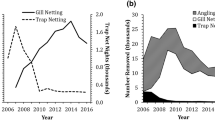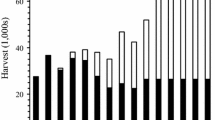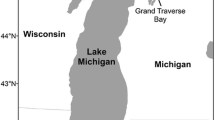Abstract
Our objective was to evaluate the long-term sustainability of lake trout Salvelinus namaycush and rainbow trout Oncorhynchus mykiss populations subjected to a range of fishing mortality (F) in Lake Pend Oreille, Idaho, USA, while providing for bull trout Salvelinus confluentus and kokanee Oncorhynchus nerka recovery. In order to achieve our objective, we developed a density-dependent stochastic predator–prey simulation model for the three major predators (lake trout, rainbow trout, and bull trout) on kokanee in Lake Pend Oreille. As F increased from 0.0 to 1.0, lake trout numbers in 2015 declined 90% for gillnetting, 76% for angling, and 48% for trap netting. At fishing mortality rates observed in Lake Pend Oreille during 2006, all methods combined and angling alone suppressed the lake trout population, but not gillnetting or trap netting alone. As F increased from 0.0 to 0.3, rainbow trout numbers in 2015 declined by 38%. Abundance of adult bull trout increased by 5.8% per year during 1996–2006, after implementation of no-kill regulations, which met the Federal Recovery Plan criterion of a stable or increasing trend in abundance. By 2010, total consumption of kokanee by lake trout, rainbow trout, and bull trout would increase by 20% if fishing mortality on lake trout and rainbow trout declined by 30% from 1996 levels, and would decrease by 14% if fishing mortality on lake trout and rainbow trout increased by 30% from 1996 levels. At rates of fishing mortality exerted on lake trout and rainbow trout in 2006, the likelihood of kokanee collapse was 65% within the next decade. Therefore, fishing mortality would need to be at least 6% higher on both lake trout and rainbow trout to reduce the likelihood of kokanee collapse to 50%. We conclude that kokanee biomass is presently out of balance with predation in Lake Pend Oreille, because kokanee production cannot compensate for all predation loss. Our findings suggest that a combination of unusually high kokanee production and unusually low predation are likely needed for kokanee to survive the next decade in Lake Pend Oreille.







Similar content being viewed by others
References
Bassista T. P., M. A. Maiolie, & M. A. Duclos, 2005. Lake Pend Oreille Predation Research. Idaho Department of Fish and Game, Fishery Research Report 05-04, Boise, Idaho.
Bowles, E. C., B. E. Rieman, G. R. Mauser, & D. H. Bennett. 1991. Effects of introductions of Mysis relicta on fisheries in northern Idaho. In Nesler, T. P. & E. P. Bergersen (eds), Mysids in Fisheries: hard Lessons from Headlong Introductions. American Fisheries Society Symposium 9, Bethesda, Maryland: 65–74.
Crossman, E. J., 1995. Introduction of the lake trout (Salvelinus namaycush) in areas outside its native distribution: a review. Journal of Great Lakes Research 21(Supplement 1): 17–29.
Donald, D. B. & D. J. Alger, 1993. Geographic distribution, species displacement, and niche overlap for lake trout and bull trout in mountain lakes. Canadian Journal of Zoology 71: 238–247.
Downs, C. C., & R. Jakubowski. 2006. Lake Pend Oreille/Clark Fork River Fishery Research and Monitoring 2005 Progress Report. Idaho Department of Fish and Game report to Avista Corporation, IDFG Report 06-41, Boise.
Fredenberg, W., 2002. Further evidence that lake trout displace bull trout in mountain lakes. Intermountain Journal of Sciences 8: 143–152.
Haddon, M., 2001. Modelling and quantitative methods in fisheries. Chapman & Hall/CRC, Boca Raton, Florida.
Hansen, M. J., 1999. Lake trout in the Great Lakes: basin-wide stock collapse and binational restoration. In Taylor, W. W. & C. P. Ferreri (eds), Great Lakes Fishery Policy and Management: a Binational Perspective. Michigan State University Press, East Lansing, Michigan: 417–453.
Hansen, M. J. 2007. Predator–prey dynamics in Lake Pend Oreille. Idaho Department of Fish and Game, Fishery Research Report 07-53, Boise, Idaho.
Hansen, M. J., J. W. Peck, R. G. Schorfhaar, J. H. Selgeby, D. R. Schreiner, S. T. Schram, B. L. Swanson, W. R. MacCallum, M. K. Burnham Curtis, G. L. Curtis, J. W. Heinrich & R. J. Young, 1995. Lake trout (Salvelinus namaycush) populations in Lake Superior and their restoration in 1959–1993. Journal of Great Lakes Research 21(Supplement 1): 152–175.
Hansen, M. J., M. Liter, S. Cameron, & N. Horner. 2007. Mark-Recapture Study of Lake Trout Using Large Trap Nets in Lake Pend Oreille. Idaho Department of Fish and Game, Fishery Research Report 07-19, Boise, Idaho.
Hansen, M. J., N. J. Horner, M. Liter, M. P. Peterson & M. A. Maiolie, 2008. Dynamics of an increasing lake trout population in Lake Pend Oreille, Idaho, USA. North American Journal of Fisheries Management 28(4): 1160–1171.
Healey, M. C., 1978. The dynamics of exploited lake trout populations and implications for management. Journal of Wildlife Management 42: 307–328.
Hoelscher, B. 1992. Pend Oreille Lake Fishery Assessment 1951 to 1989. Idaho Department of Health and Welfare, Division of Environmental Quality Community Programs, Boise, Idaho.
Johnson, L., 1976. Ecology of arctic populations of lake trout, Salvelinus namaycush, lake whitefish, Coregonus clupeaformis, Arctic char, S. alpinus, and associated species in unexploited lakes of the Canadian Northwest Territories. Journal of the Fisheries Research Board of Canada 33: 2459–2488.
Keleher, J. J., 1972. Great Slave Lake: effects of exploitation on the salmonid community. Journal of the Fisheries Research Board of Canada 29: 741–753.
Maiolie, M. A., M. P. Petersen, W. J. Ament, & W. Harryman. 2006. Kokanee Response to Higher Winter Lake Levels in Lake Pend Oreille During 2005. Idaho Department of Fish and Game, Fishery Research Report 06-31, Boise, Idaho.
Maiolie, M. A., G. P. Schoby, W. J. Ament, & B. Harryman. 2008. Kokanee and Rainbow Trout Research Efforts, Lake Pend Oreille, 2006. Idaho Department of Fish and Game, Fishery Research Report 08-06, Boise, Idaho.
Martin, N. V., & T. G. Northcote. 1991. Kootenay Lake: an inappropriate model for Mysis relicta introduction in north temperate lakes. In Nesler, T. P. & E. P. Bergersen (eds), Mysids in Fisheries: hard Lessons from Headlong Introductions. American Fisheries Society Symposium 9, Bethesda, Maryland: 23–29.
Martin, N. V. & C. H. Olver, 1980. The lake charr, Salvelinus namaycush. In Balon, E. (ed.), Charrs: Salmonid Fishes of the Genus Salvelinus. Junk Publishers, The Hague, The Netherlands: 205–277.
Myers, R. A., 2002. Recruitment: understanding density-dependence in fish populations. In Hart, P. J. B. & J. D. Reynolds (eds), Handbook of Fish Biology and Fisheries, Vol. 1. Fish Biology. Blackwell Publishing, Malden, Massachusetts: 123–148.
Myers, R. A., K. G. Bowen & N. J. Barrowman, 1999. The maximum reproductive rate of fish at low population sizes. Canadian Journal of Fisheries and Aquatic Sciences 56: 2404–2419.
Nieland, J. L. 2006. Modeling the Sustainability of Lake Trout Fisheries in Eastern Wisconsin Waters of Lake Superior. Master’s thesis, University of Wisconsin-Stevens Point.
Olver, C. H., D. Nadeau & H. Fournier, 2004. The control of harvest in lake trout fisheries on Precambrian Shield lakes. In Gunn, J. M., R. J. Steedman & R. A. Ryder (eds), Boreal Shield Watersheds: Lake Trout Ecosystems in a Changing Environment. Lewis Publishers, Boca Raton, Florida: 193–218.
Quinn II, T. J. & R. B. Deriso, 1999. Quantitative fish dynamics. Oxford University Press, New York, New York.
Ricker, W. E., 1975. Computation and interpretation of biological statistics of fish populations. Bulletin 191 of the Fisheries Research Board of Canada, Ottawa, Canada.
Rieman, B. E., 1977. Lake Pend Oreille Limnological Studies. Idaho Department of Fish and Game, Job Performance Report, Project F-53-R-12, Job IV-d, Boise, Idaho.
Stafford, C. P., J. A. Stanford, F. R. Hauer & E. B. Brothers, 2002. Changes in lake trout growth associated with Mysis relicta establishment: a retrospective analysis using otoliths. Transactions of the American Fisheries Society 131: 994–1003.
Vidergar, D. T., 2000. Population Estimates, Food Habits and Estimates of Consumption of Selected Predatory Fishes in Lake Pend Oreille, Idaho. Master’s thesis. University of Idaho, Moscow, Idaho.
Acknowledgments
Ned Horner, Chip Corsi, Melo Maiolie, Bill Harryman, Seth Cameron, Mark Liter, Chris Downs, Jake Miller, Greg Schoby, Bill Ament, and Mark Duclos provided data and intellectual support. Nancy Nate provided data management support. The University of Wisconsin-Stevens Point, the University of Wisconsin Sea Grant Institute under grants from the National Sea Grant College Program, National Oceanic and Atmospheric Administration (Project Number R/LR-95) and Avista Utilities provided funding for the senior author’s salary during sabbatical, during which this experimental study was completed.
Author information
Authors and Affiliations
Corresponding author
Additional information
Guest editors: C. Adams, E. Brännas, B. Dempson, R. Knudsen, I. McCarthy, M. Power, I. Winfield / Developments in the Biology, Ecology and Evolution of Charr
Rights and permissions
About this article
Cite this article
Hansen, M.J., Schill, D., Fredericks, J. et al. Salmonid predator–prey dynamics in Lake Pend Oreille, Idaho, USA. Hydrobiologia 650, 85–100 (2010). https://doi.org/10.1007/s10750-010-0299-3
Received:
Accepted:
Published:
Issue Date:
DOI: https://doi.org/10.1007/s10750-010-0299-3




